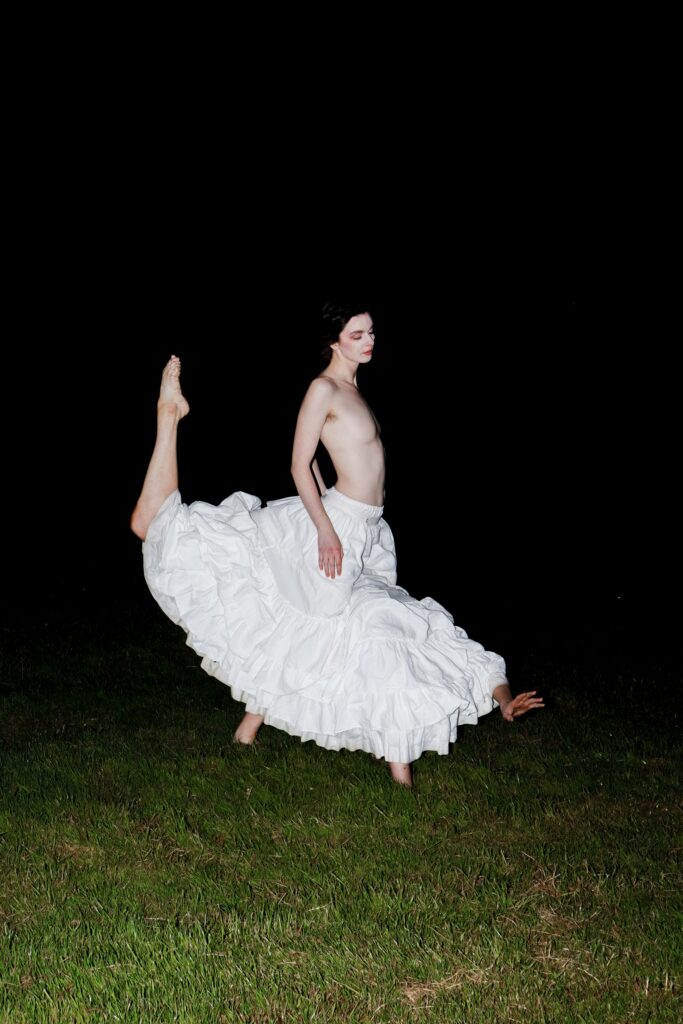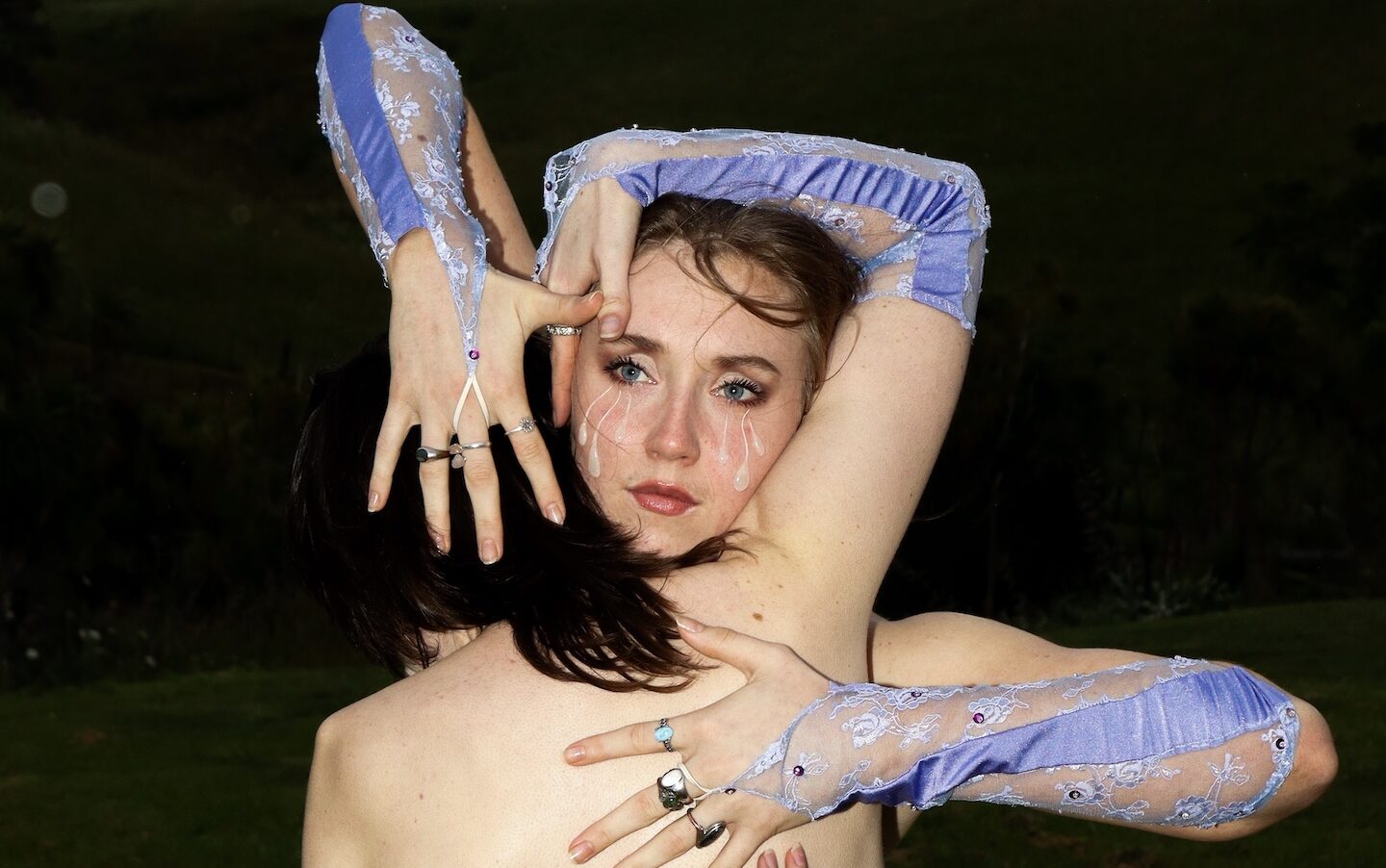Only the Stars Know Where I’ve Been is a work that has been living with its collaborators for a long time. Choreographer Jake Starrs and dancers Sydney Magnus and Stella Grace Seawright grew together as artists, friends and people during their time at study. Throughout the first couple years following graduation, they have navigated their own separate lives with this work as a continuous point of return. The work has grown and changed as the people making it have, and almost a full year of development later, Only the Stars Know Where I’ve Been is stepping out into the light of day.
The show is dense and beautiful, with two surreal and magical creatures traversing nocturnal landscapes, all to present their gritty hearts. The dancers are not from this world, yet their hearts are just like our own: messy, tangled, beating. Love is complicated, and developing your identity is hard, no matter which plane of existence you come from.

Choreographer Jake Starrs suggests “It is a look at how our history and experiences innately shape our pathway towards the future. It’s a sort of a dialogue between whether our imagined futures and reality are aligned, or detached.”
“Queer Temporality explores the idea, from a Western cultural perspective, that time is experienced differently for those who occupy a queer identity.”
All of the people involved in telling this story are queer, so by nature, this magically difficult coming-of-age story has a queer lens. Though not explicitly intentional, it hosts an undercurrent of Queer Temporality, which is a new theory currently developing in modern philosophy. Queer Temporality explores the idea, from a Western cultural perspective, that time is experienced differently for those who occupy a queer identity. Growth into ‘adulthood’ is not linear, and time seems to fold in and bubble up in peculiar ways as queer folk navigate growing up with no clear template of who and how they should be.
The title is equally as mysterious as the work and has prompted a lot of nebulous questions. Starrs provides some insight:
“It’s the sense that the stars in the sky are these passive watchers of our lives. After dark, when the stars are out, I feel freer. As if my truer self emerges at that time. The stars are always there, not intervening, just watching from afar—they’ve seen me in the darkest hours. They’ve seen me share my secrets.”
This state of honesty with oneself, witnessed by the stars and the sky, can be uncomfortable, and the work addresses that. Magnus and Seawright physically exert and contort themselves, embodying the complicated mental processes of reckoning with the past versions of themselves, and deciding which to let go of. They search for and are confronted by ghosts of self within each other and inside themselves. Starrs is intrigued by “The forgotten bits of our mind, the subconscious, which crops up at strange times, and almost innately shapes us.”
When asked to describe the work with a texture, Starrs said it was “the texture of crumpled paper.” It’s the kind of paper that wears the consequences of its life on its skin, and because of this, “it can be torn, but it’s also able to be remoulded into another form.”

Though the dancers are most certainly more solid than paper, this moulding and reforming is a very apt summary of Only the Stars Know Where I’ve Been. The dancers become tender parasites, loving one another so intensely they form their identities from pieces of each other in viciously precise duets, and expanding and shrinking by turn in the absence of one another. As someone who is not directly inside the work but considers all the people in it among my closest friends, I admire these artists’ ability to toe the line between abstract and specific. I can recognise that feeling, I recognise that emotion, and I can relate it to my life, even though my life is different to both the dancers and the choreographer, and I have no idea who the dancers are ‘supposed’ to be onstage. As three friends who have grown up a lot together, they work to hold a strong emotional core.
These emotions are almost ritualised, but even though I have watched it many times, I am still left with questions that nourish me in my attempts to answer them: Are these emotions ritualised deliberately, as a way to get out of them through repetition to the point of understanding, or are the dancers out of control? Are they experiencing these things again and again, in that painfully circular tension that growing up has, where no matter how hard you try to grow out of them, childhood hopes and anxieties keep coming back?
When asked about his hopes for the performance season, Starrs said plainly “I hope that people come. I hope people can reflect and experience, and I hope that people can think and like it or hate it, or just feel some type of way about it. I hope that people can be able to sit with their thoughts, and know that they’re okay to do that in this space.”
It’s an honest and earnest hope, that the work serves. The performance creates a space that holds. It holds you in the setting, and it’s not necessarily an uncomfortable confrontation of thoughts. When I watch it, I can be distracted by the beautiful dancing, and just focus on that if I want. Or I can let the beautiful dancing hold me and hold my thoughts together, and allow me just have a chat with them.
Only the Stars Know Where I’ve Been is being performed at Basement Theatre in Tāmaki Makaurau from Tuesday 5 until Saturday 9 March. You can purchase tickets on a ‘choose what you pay’ basis via the Basement website or directly on iTicket.
Featured photos by Jordan Parkinson courtesy of Ctenophora Co.



